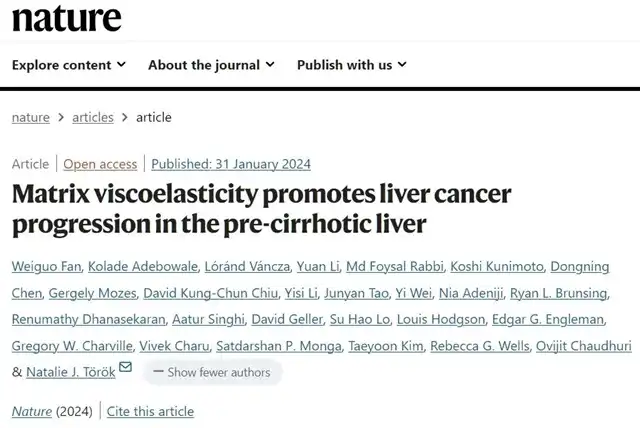Type 2 Diabetes’s Hidden Role in Accelerating Liver Cancer Growth
- Normal Liver Cells Found to Promote Cancer Metastasis to the Liver
- Nearly 80% Complete Remission: Breakthrough in ADC Anti-Tumor Treatment
- Vaccination Against Common Diseases May Prevent Dementia!
- New Alzheimer’s Disease (AD) Diagnosis and Staging Criteria
- Breakthrough in Alzheimer’s Disease: New Nasal Spray Halts Cognitive Decline by Targeting Toxic Protein
- Can the Tap Water at the Paris Olympics be Drunk Directly?
Type 2 Diabetes’s Hidden Role in Accelerating Liver Cancer Growth
- Should China be held legally responsible for the US’s $18 trillion COVID losses?
- CT Radiation Exposure Linked to Blood Cancer in Children and Adolescents
- FDA has mandated a top-level black box warning for all marketed CAR-T therapies
- Can people with high blood pressure eat peanuts?
- What is the difference between dopamine and dobutamine?
- How long can the patient live after heart stent surgery?
Type 2 Diabetes’s Hidden Role in Accelerating Liver Cancer Growth
Scientists have made a groundbreaking discovery, revealing that increased liver elasticity is a key factor in promoting liver cancer in type 2 diabetes.
Risk factors for hepatocellular carcinoma (HCC) include type 2 diabetes (T2DM) and cirrhosis. However, research indicates that in non-alcoholic steatohepatitis (NASH)-related liver cancer, about 30% actually occurs in the early stages of cirrhosis when the liver cell matrix remains “soft,” and these patients often face blood sugar control issues.
Why is there a connection between type 2 diabetes, blood sugar, and liver cancer?
This week, a scientific team from Stanford University published a paper in the journal “Nature,” unveiling how type 2 diabetes transforms the liver into a conducive environment for cancer cell growth.
The researchers discovered that advanced glycation end-products (AGEs) accumulated in the characteristic extracellular matrix (ECM) of type 2 diabetes play a role in changing collagen structure and enhancing the elasticity of the ECM. This, in turn, activates the YAP pathway, promoting the occurrence of liver cancer.

It’s worth noting that AGEs are not only caused by diseases but are also abundant in high-temperature-cooked foods rich in oil, sugar, and protein. So, paying attention to diet is crucial.
The researchers initially analyzed the mechanical characteristics of type 2 diabetes and NASH liver samples. Compared to healthy individuals, individuals with type 2 diabetes exhibited significantly higher levels of liver AGEs, similar hardness, but with higher viscosity and elasticity, likened to the feeling of dough being pressed.
The researchers also fed mice a high-AGE diet (HiAD). Compared to mice on a normal diet or a high-fat diet, HiAD mice showed significant liver degeneration, insulin resistance, and higher liver AGEs, with increased liver elasticity.
To investigate the impact of highly elastic livers on the occurrence of liver cancer, researchers delivered human MET mutation β-catenin to mice, simulating the metabolic/matrix environment before tumor seeding.
Compared to the control group, HiAD mice grew tumor lesions earlier, and the tumors grew faster. Using inhibitors to disrupt AGE and collagen cross-linking reduced tumor growth and increased mouse survival.
Through second harmonic imaging and two-photon microscopy of human and mouse liver samples, the researchers observed collagen networks. After AGE cross-linking, the interconnectivity of the collagen network decreased, collagen fiber length shortened, and heterogeneity increased, resulting in increased tissue elasticity.
So, why does this become a breeding ground for liver cancer?
Researchers conducted RNA sequencing and bioinformatics analysis of liver tissue and found an enrichment of YAP/TAZ regulatory genes in HiAD mouse livers. Increased tissue elasticity alone is enough to activate this pathway and cell proliferation. Further exploration of the mechanism revealed that elasticity promotes liver cancer through the molecular pathway of integrin β1-TNS1-YAP.
The researchers emphasized a crucial point. Current liver cancer screening mainly targets individuals with cirrhosis. Still, this study found a close relationship between high elasticity and liver cancer, especially for type 2 diabetes patients, where liver cancer often occurs without cirrhosis.
Given this situation, researchers believe that guidelines should include recommendations for liver cancer screening for type 2 diabetes patients, especially since type 2 diabetes is not just a risk factor for one type of cancer.
Type 2 Diabetes’s Hidden Role in Accelerating Liver Cancer Growth
(source:internet, reference only)
Disclaimer of medicaltrend.org
Important Note: The information provided is for informational purposes only and should not be considered as medical advice.



